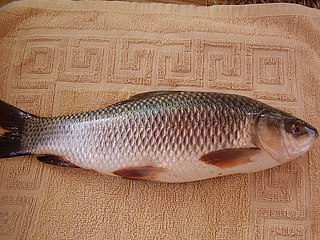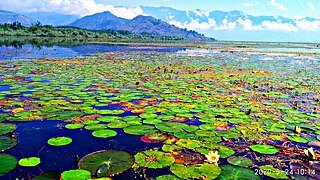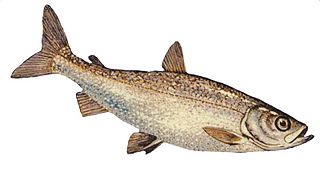
The Indus is a transboundary river of Asia and a trans-Himalayan river of South Asia. The 3,180 km (1,980 mi) river rises in Western Tibet, flows northwest through the Ladakh and Gilgit-Baltistan regions of Kashmir, bends sharply to the left after the Nanga Parbat massif, and flows south-by-southwest through Pakistan, before it empties into the Arabian Sea near the port city of Karachi.

Lake Manchar, also spelled Manchhar, is the largest natural freshwater lake in Pakistan, and is one of Asia's largest. It is located west of the Indus River, in Jamshoro District and Dadu District, Sindh - 18 km away from Sehwan Sharif. Lake Manchar collects water from numerous small streams in the Kirthar Mountains, and then empties into the Indus River. The lake's surface area fluctuates with the seasons - from as little as 36 km², to as much as 500 km² during monsoon rains.

The rohu, rui, or roho labeo is a species of fish of the carp family, found in rivers in South Asia. It is a large omnivore and extensively used in aquaculture.

Catla, also known as the major South Asian carp, is an economically important South Asian freshwater fish in the carp family Cyprinidae. It is native to rivers and lakes in northern India, Bangladesh, Myanmar, Nepal, and Pakistan, but has also been introduced elsewhere in South Asia and is commonly farmed.

Wular Lake is one of the largest fresh water lakes in Asia. It is sited in Bandipora district in Jammu and Kashmir, India. The lake basin was formed as a result of tectonic activity and is fed by the Jhelum River. The lake's size varies seasonally from 12 to 100 square miles. In addition, much of the lake has been drained as a result of willow plantations being built on the shore in the 1950s.

The yoyo loach, Almora loach or Pakistani loach is a freshwater fish belonging to the loach family Botiidae. It originates in the slow-running and still waters of the Ganges basin in northern India and possibly Nepal. Despite the alternative common name Pakistani loach, the true B. almorhae is not known from Pakistan.

Freshwater fish are those that spend some or all of their lives in fresh water, such as rivers and lakes, with a salinity of less than 1.05%. These environments differ from marine conditions in many ways, the most obvious being the difference in levels of salinity. To survive fresh water, the fish need a range of physiological adaptations.

The freshwater whitefish are fishes of the subfamily Coregoninae, which contains whitefishes and ciscoes, and is one of three subfamilies in the salmon family Salmonidae. Apart from the subfamily Coregoninae, the family Salmonidae includes the salmon, trout, and char species of the subfamily Salmoninae, and grayling species of the subfamily Thymallinae. Freshwater whitefish are distributed mainly in relatively cool waters throughout the northern parts of the Northern Hemisphere.

Fishing in India is a major industry employing 14.5 million people. India ranks second in aquaculture and third in fisheries production. Fisheries contributes to 1.07% of the Total GDP of India. According to the National Fisheries Development Board the Fisheries Industry generates an export earnings of Rs 334.41 billion. Centrally sponsored schemes will increase exports by Rs 1 lakh crore in FY25. 65,000 fishermen have been trained under these schemes since year 2017 to year 2020. Freshwater consists 55% of total fish production.

Badis badis, also known as the blue perch or blue badis, is a small species of Asian freshwater fish in the family Badidae of the order Anabantiformes. It is found in ponds, rivers, ditches and swamps in northern India, eastern Pakistan, Bangladesh, Bhutan and Nepal, including the Ganges, Brahmaputra, Mahanadi and Indus basins. It is sometimes kept as an aquarium fish. It is a small, predatory fish that feeds on tiny invertebrates. Maximum total length is around 8 cm (3 in). It is sexually dimorphic, with males growing larger and being more colorful, especially when excited, compared to females. Adult males have blue fins and may display dark vertical bands on the flanks, while the smaller females display little color. Several similar relatives, now recognized as separate Badis species, have historically been confused with Badis badis. Historically the two genera that now make up the Badidae, Badis and Dario, were placed in the family Nandidae; this is no longer the case.

Pakistan's native fauna reflect its varied climatic zones.

The mrigal carp, also known as the white carp, is a species of ray-finned fish in the carp family. Native to streams and rivers in India, the only surviving wild population is in the Cauvery River, leading to its IUCN rating as vulnerable. It is widely aquafarmed and introduced populations exist outside its native range. It reaches a maximum length of 1 m (3.3 ft). This species and Cirrhinus mrigala are considered distinct.
Schizopyge is a genus of cyprinid freshwater fish found in Pakistan and the northwestern part of India. Schizopyge is closely related to Schizothorax and some species have historically been moved between the two genera.
Schizopyge niger, the Alghad snowtrout, is a species of cyprinid freshwater fish that lives in cold lakes and nearby channels in the Kashmir region in India and Pakistan. It reaches up to about 33 cm (13 in) in standard length.

The scaly osman is a species of cyprinid freshwater fish. It is native to Himalaya and the Tibetan Plateau of China, India, Nepal and Pakistan, ranging west to the Tien Shan Mountains and Central Asia. It is up to 70 cm (2.3 ft) in total length.

Fishery and fishing industry plays a significant part in the national economy of Pakistan. With a coastline of about 814 km, Pakistan has enough fishery resources that remain to be developed. Most of the population of the coastal areas of Sindh and Balochistan depends on fisheries for livelihood. It is also a major source of export earning.
Chuanchia labiosa is a species of cyprinid fish that is only found in the upper reaches of the Yellow River basin in the Qinghai–Tibet Plateau of China, where it mostly inhabits slow-flowing cold waters at altitudes above 3,000 m (9,800 ft). It is the only member of its genus, but is related to other schizothoracines like Aspiorhynchus, Diptychus, Gymnodiptychus, Gymnocypris, Oxygymnocypris, Platypharodon, Ptychobarbus, Schizopyge, Schizopygopsis and Schizothorax.
Ptychobarbus is a genus of cyprinid fish that is found in rivers, streams and lakes in the Himalayas and Tibetan Plateau of China, India, Nepal and Pakistan, extending into the highlands of Afghanistan. They reach up to 2.2 kg (5 lb) in weight and about 65 cm (2.1 ft) in total length. They mostly feed on benthic invertebrates, but will also take planktonic organisms, aquatic plants and algae.

The Badidae are a small family which has been placed in the order anabantiforme fishes. However, the 5th edition of Fishes of the World classifies the family as being a sister to the Anabantiformes, along with the Nandidae and Pristolepididae in an unnamed and unranked but monophyletic clade which is a sister to the Ovalentaria within the wider Percomorpha. Members of this family are small freshwater fish that are found in Bangladesh, Bhutan, China, India, Laos, Myanmar, Nepal, Pakistan and Thailand. The largest is Badis assamensis that reaches a standard length of up to 7.5 cm (3 in), while the smallest, Dario dario, does not exceed 2 cm (0.8 in).

Tor tor, commonly known as the tor mahseer or tor barb, is a species of cyprinid fish found in fast-flowing rivers and streams with rocky bottoms in India, Bangladesh, Bhutan, Nepal, and Pakistan. It is a commercially important food and game fish.














